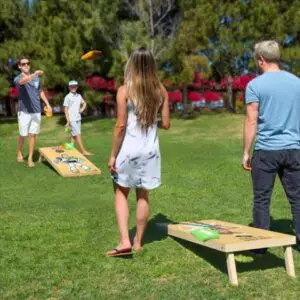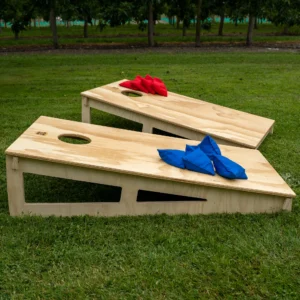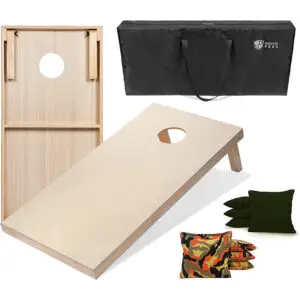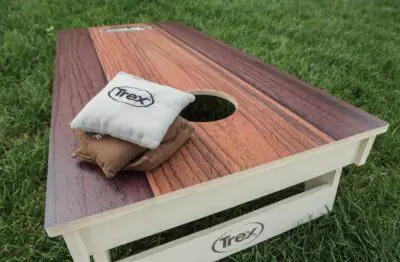Cornhole, also known as bean bag toss, is a popular backyard game that requires players to throw bags filled with corn or beans at a raised platform with a hole in the center. To play cornhole, it is essential to have the correct corn hole dimensions for the cornhole board and the placement of the hole.
In this article, we will discuss the standard cornhole dimensions to help you set up a proper playing area for this fun and exciting game.
What is cornhole, and how is it played?

Cornhole is a popular backyard game that involves throwing bags filled with corn or beans at a raised platform with a hole in the center. The game is also known as bean bag toss, baggy, or bags. It can be played by two or more players or teams, and the objective is to score points by landing the bags on the board or in the hole.
To play cornhole, you will need two cornhole boards, each measuring 2 feet wide and 4 feet long. The boards should be set up facing each other with a distance of 27 feet between the front edges. Each board should be raised 12 inches from the ground at the back end and tilted slightly upward towards the front end, where the hole is located.
Players take turns throwing four bags each, trying to land them on the board or in the hole. A bag that lands on the board is worth one point, while a bag that goes through the hole is worth three points. The player or team with the most points at the end of the game is declared the winner.
Cornhole is a simple and fun game that can be played by people of all ages and skill levels. It is a great way to spend time outdoors with family and friends and can be played at picnics, barbecues, and other outdoor events.
What are the official cornhole dimensions and regulations?
The American Cornhole Association (ACA) has established official regulations and dimensions for cornhole boards and bags. According to the ACA, a cornhole board should measure 2 feet in width and 4 feet in length, with a hole that is 6 inches in diameter and centered 9 inches from the top edge of the board.
The board should be tilted slightly upward, with the front edge measuring 2.5-4 inches off the ground and the back edge measuring 12 inches off the ground.
Cornhole bags should be made of duck cloth and filled with dried corn or synthetic materials. Each bag should weigh between 14-16 ounces and measure 6 inches by 6 inches.
The ACA also has rules regarding the distance between the cornhole boards. The front edges of the boards should be placed 27 feet apart for official tournament play, but this distance can be adjusted for recreational play.
In addition to these official dimensions and regulations, there are also various other rules that can be established for cornhole gameplay, such as scoring systems and foul rules. It is important to establish these rules before playing to ensure fair play and avoid confusion.
How to make your own cornhole boards and bags
Making your own cornhole boards and bags is a great way to customize your playing equipment while also saving money. Here are the steps for making your own cornhole boards and bags:
Cornhole Boards:
- Gather your materials: You will need two sheets of plywood measuring 2 feet by 4 feet, four pieces of 2×4 lumber measuring 8 feet long, screws, a saw, a drill, measuring tape, and sandpaper.
- Cut the lumber: Cut the 2×4 lumber into four pieces measuring 48 inches long and four pieces measuring 21 inches long.
- Assemble the frame: Use the 48-inch pieces to create the frame for the cornhole board, securing the pieces together with screws. Then, attach the 21-inch pieces at each end to create legs that angle the board slightly upward.
- Attach the plywood: Cut a 6-inch hole centered 9 inches from the top of each board, then attach the plywood to the frame using screws.
- Sand and paint: Sand the boards to smooth any rough edges and paint them in your desired colors.
Cornhole Bags:
- Gather your materials: You will need duck cloth, a sewing machine, thread, a measuring tape, scissors, and dried corn or synthetic materials for filling.
- Cut the fabric: Cut the duck cloth into squares measuring 7 inches by 7 inches.
- Sew the bags: Place two pieces of fabric together with the right sides facing each other and sew three sides together. Then, turn the bag right side out and fill it with corn or synthetic materials. Finally, sew the remaining side closed.
- Repeat: Repeat this process to make a total of eight bags, four for each team.
By following these steps, you can create your own cornhole boards and bags for hours of fun and entertainment with family and friends.
The different types of cornhole boards and materials used

Cornhole boards can be made from a variety of materials, each with its own advantages and disadvantages. Here are some of the most common types of cornhole boards and materials used:
- Wood: Wood is the most traditional material used for cornhole boards. Plywood and pine are commonly used, but hardwoods like maple and oak can also be used for a higher-quality board. Wood is durable and easy to work with, but it can be heavy and may warp over time if not stored properly.
- Plastic: Plastic cornhole boards are lightweight and weather-resistant, making them ideal for outdoor play. They are also easy to clean and maintain. However, plastic boards may not have the same level of durability as wooden boards and may not provide the same playing experience.
- Metal: Metal cornhole boards are strong and durable, but they are also heavy and can be difficult to move around. They are weather-resistant and can provide a unique look, but they can also be noisy when bags hit them.
- Composite: Composite boards are made from a combination of materials, such as plastic and wood fibers. They are lightweight, weather-resistant, and durable. Composite boards can also be made to look like wood, providing a traditional look with modern benefits.
- Custom: Some cornhole players prefer to create custom boards, using materials like glass or metal, to add a unique touch to their game. Custom boards can be expensive, but they provide a one-of-a-kind playing experience.
When choosing a material for your cornhole boards, consider your playing needs, budget, and personal preferences.
How to properly set up a cornhole game
To properly set up a cornhole game, follow these steps:
- Choose a flat, level playing surface. Cornhole can be played on grass, concrete, or any other flat surface, but it’s important to make sure the surface is level to ensure fair play.
- Place the boards 27 feet apart from front edge to front edge. This is the regulation distance for official cornhole play. If you’re playing for fun, you can adjust the distance as needed.
- Make sure the boards are facing each other, with the holes on opposite ends. The holes should be 12 inches in diameter and centered 9 inches from the top of the board and 12 inches from each side edge.
- Each player or team should have four bags of one color. The bags should be filled with approximately 1 pound of corn or another suitable filling and should be 6 inches by 6 inches in size.
- Determine which team will go first. This can be done by flipping a coin or playing rock-paper-scissors.
- Players will take turns throwing their bags at the opposite board. The objective is to get the bag into the hole or to land it on the board for points. Points are awarded for bags that land on the board or in the hole, with different values assigned to each.
- The game continues until one team reaches a score of 21 or more points. If both teams have the same score at the end of a round, additional rounds can be played until a winner is determined.
By following these steps, you can set up a fair and enjoyable cornhole game for you and your friends or family.
Tips for throwing the cornhole bags accurately
Cornhole is a fun outdoor game that involves throwing bags filled with corn at a raised platform with a hole in it. To score points, players need to toss the bags through the hole or land them on the platform. However, accurate throwing can be a bit tricky for beginners.
Here are some tips to help you throw the cornhole bags accurately:
- Start with the right stance: Stand with your feet shoulder-width apart and face the board. Keep your weight evenly distributed on both feet, and avoid leaning too far forward or backward.
- Use the right grip: Hold the bag with your dominant hand, and make sure it’s flat and not curled up. Place your thumb on the top of the bag and your fingers on the bottom. Use a firm grip but don’t squeeze too hard.
- Find your throwing distance: Start by standing about 15 feet away from the board. You can adjust the distance based on your skill level and personal preference.
- Follow through: When you throw the bag, make sure you follow through with your arm. This means extending your arm forward and pointing at the target.
- Practice makes perfect: The more you play, the better you’ll get. Don’t get discouraged if you don’t get it right away. Keep practicing and experimenting with different throwing techniques until you find what works best for you.
The different cornhole game variations and rules
Cornhole is a popular outdoor game that can be played in a variety of ways, with different variations and rules.
Here are some of the most common cornhole game variations:
- Regular Cornhole: This is the classic cornhole game where players toss bags filled with corn at a raised platform with a hole in it. Players take turns throwing bags and scoring points by landing on the board or getting the bag through the hole.
- Double-Play Cornhole: In this version of the game, players throw two bags each turn instead of one. The bags can be thrown from the same spot or from different distances, depending on the rules agreed upon before the game starts.
- Blind Draw Cornhole: This is a team game where players are randomly paired with a partner before the game starts. Each team member takes turns throwing bags, and the team with the highest combined score at the end of the game wins.
- Round Robin Cornhole: This is a tournament-style game where teams play multiple rounds against different opponents. The team with the most wins at the end of the tournament is declared the winner.
- Cornhole Golf: In this variation, players must throw their bags into different designated holes or targets in a specific order, similar to a golf course.
The rules for cornhole can vary depending on the game variation being played. However, some basic rules apply to most versions of the game:
- Players take turns throwing bags.
- Bags must be thrown from behind the designated throwing line.
- Bags that land on the board are worth one point, while bags that go through the hole are worth three points.
- The game is typically played until one team reaches 21 points, but this can be adjusted based on the rules agreed upon before the game starts.
- If a bag hits the ground before landing on the board, it does not count and should be removed from the playing area.
Overall, cornhole is a versatile and fun game that can be enjoyed by players of all skill levels. Whether you’re playing with friends or competing in a tournament, the game offers endless opportunities for friendly competition and outdoor fun.
How to score a cornhole game

Scoring a cornhole game is fairly straightforward and is based on the number of bags that are on the board or in the hole.
Here are the basic steps for scoring a cornhole game:
- Start by tallying the number of bags that are on the board or in the hole for each team.
- Count the bags that are on the board. Each bag that is on the board is worth one point.
- Count the bags that have gone through the hole. Each bag that goes through the hole is worth three points.
- Add up the total number of points for each team.
- Subtract the lower score from the higher score to determine the difference.
- The team with the higher score at the end of the round gets the difference in points.
For example, if Team A has 2 bags on the board and 1 bag through the hole, their total score would be 5 (2 points for the bags on the board, plus 3 points for the bag through the hole). If Team B has 3 bags on the board and 0 bags through the hole, their total score would be 3. The difference in scores would be 2 points (5-3), so Team A would receive 2 points for that round.
The game is typically played until one team reaches 21 points, but this can be adjusted based on the rules agreed upon before the game starts.
Strategies for winning cornhole games
Cornhole is a fun game that can be enjoyed by people of all ages and skill levels. Winning a game of cornhole requires a combination of skill, strategy, and luck.
Here are some strategies that may help you improve your chances of winning a cornhole game:
- Focus on accuracy: Cornhole is a game of precision, so practicing your throws and honing your accuracy can give you a significant advantage. Take the time to find the right stance, grip, and throwing distance that works best for you.
- Play to your strengths: If you’re better at throwing from a certain angle or distance, focus on that and try to create opportunities to play to your strengths.
- Use spin and trajectory: Adding spin or changing the trajectory of your throw can help you control where the bag lands and increase your chances of scoring.
- Block your opponent: Try to block your opponent’s shots by strategically placing your bags on the board. This can limit their scoring opportunities and increase their chances of winning.
- Play defensively: If you’re ahead in points, focus on playing defensively by aiming for the board rather than the hole. This can prevent your opponent from scoring and help you maintain your lead.
- Stay focused: Cornhole is a game of concentration, so try to stay focused and avoid distractions. Take deep breaths, visualize your throws, and maintain a positive attitude.
- Have fun: Above all, remember that cornhole is a fun game that’s meant to be enjoyed with friends and family. Don’t get too caught up in winning and losing, and focus on having a good time.
Recommended:
- How much does a bench bar weigh?
- How much does a walrus weigh?
- How many square feet is 30×30?
- How heavy is 21 tons?
- How much does a tuba weigh?
The common mistakes to avoid when playing cornhole
Cornhole is a fun and popular game that can be enjoyed by players of all skill levels. However, there are some common mistakes that can prevent you from playing your best and winning the game.
Here are some of the most common mistakes to avoid when playing cornhole:
- Overthrowing or underthrowing: One of the most common mistakes in cornhole is throwing the bag too hard or not hard enough. It’s important to find the right balance between power and accuracy and to adjust your throws based on the distance and wind conditions.
- Focusing too much on the hole: While landing the bag in the hole can be a great way to score points, it’s important not to focus too much on the hole and forget about the board. Landing the bag on the board can also score points and can be a good strategy for blocking your opponent.
- Inconsistent technique: Having an inconsistent technique can lead to inconsistent results. Try to develop a consistent throwing technique, including your stance, grip, and release, to improve your accuracy and consistency.
- Poor foot placement: The position of your feet can affect your balance and your throwing motion. Make sure your feet are planted firmly and evenly behind the throwing line and adjust your stance as needed to accommodate for different throwing distances.
- Not paying attention to opponents’ bags: It’s important to pay attention to where your opponents’ bags land on the board, as this can affect your strategy and your scoring opportunities. Keep an eye on your opponent’s bags and adjust your strategy accordingly.
- Getting distracted: Cornhole is a game of concentration, and getting distracted can lead to mistakes and missed opportunities. Stay focused on the game, avoid distractions, and take deep breaths or other relaxation techniques to help you stay calm and focused.
By avoiding these common mistakes and practicing your technique, you can improve your chances of playing your best and enjoying a fun and competitive game of cornhole.
Conclusion
Cornhole is a popular lawn game that is played with two boards and bags filled with corn or plastic pellets. It is important you know the corn hole dimensions, rules, and regulation of the game to enjoy it. The boards used in cornhole are typically rectangular in shape and measure 2 feet in width and 4 feet in length.
The boards are placed 27 feet apart from each other, with a 6-inch hole centered 9 inches from the top of the board. The bags used in cornhole are 6 inches by 6 inches and filled with corn or plastic pellets. Knowing the dimensions of cornhole boards and bags is important for setting up and playing the game correctly.
With the right equipment and setup, players can enjoy a fun and competitive game of cornhole with friends and family.


